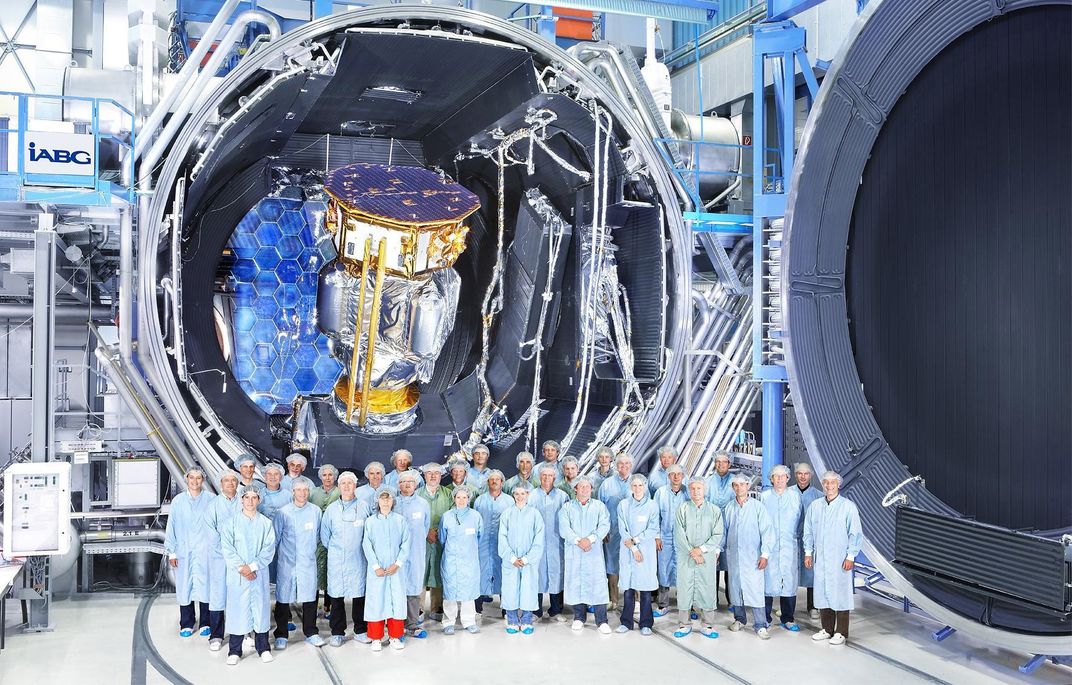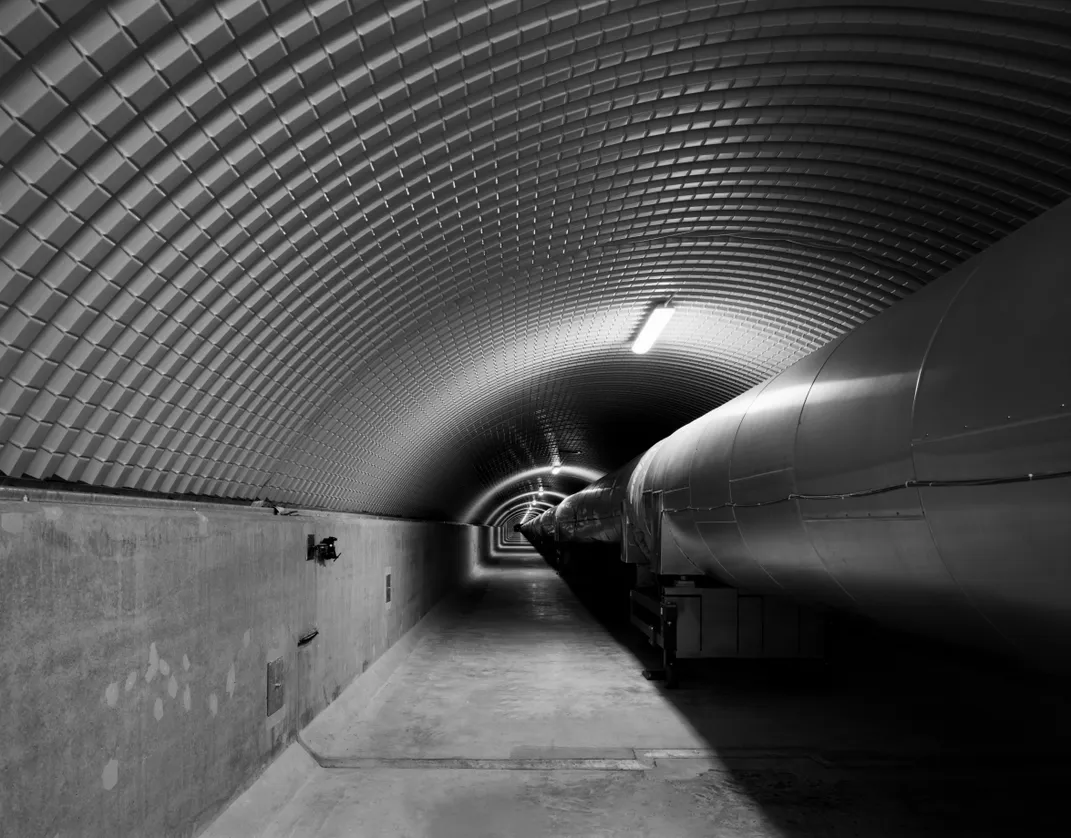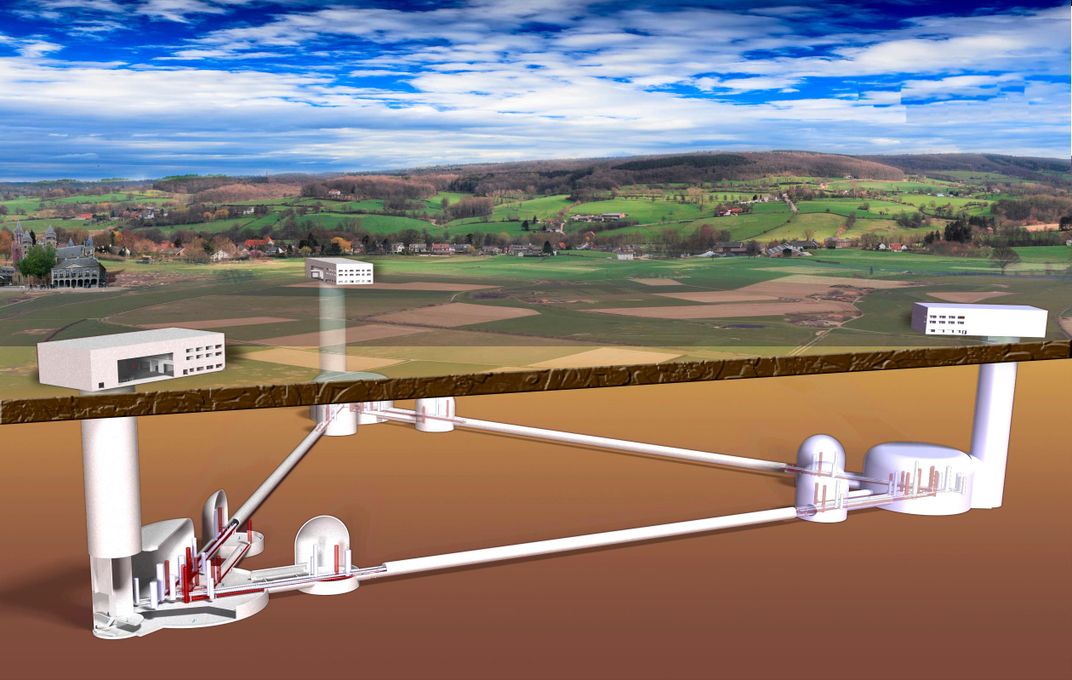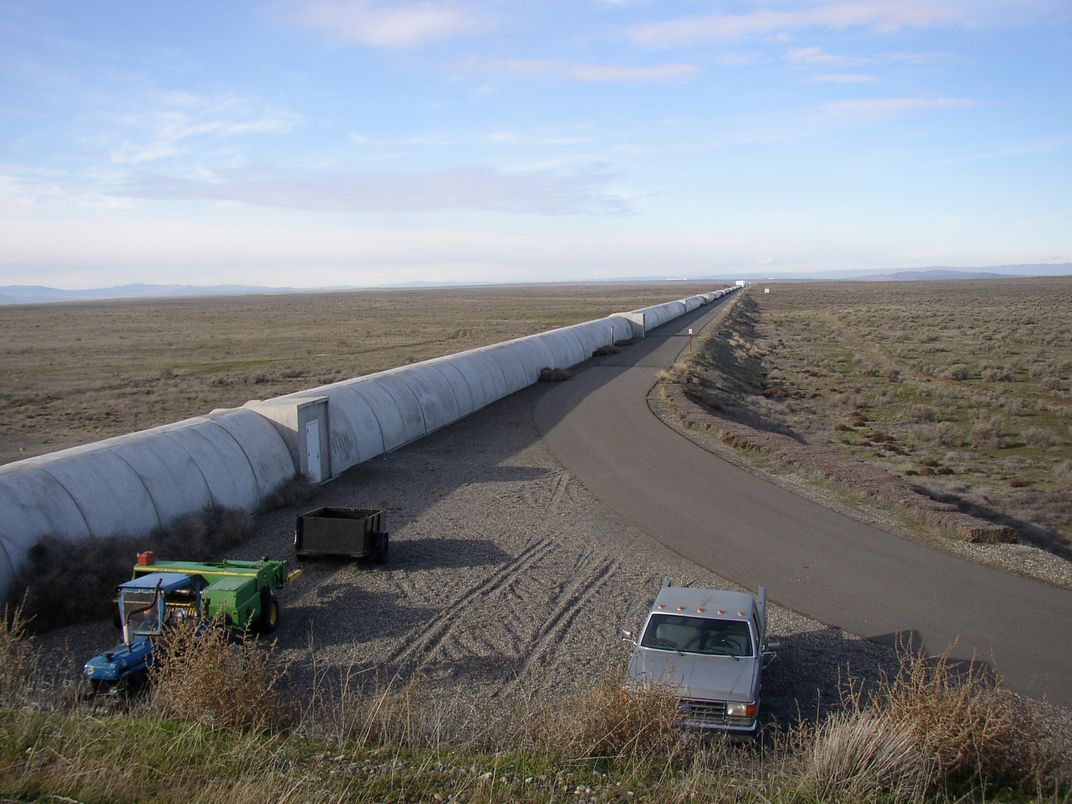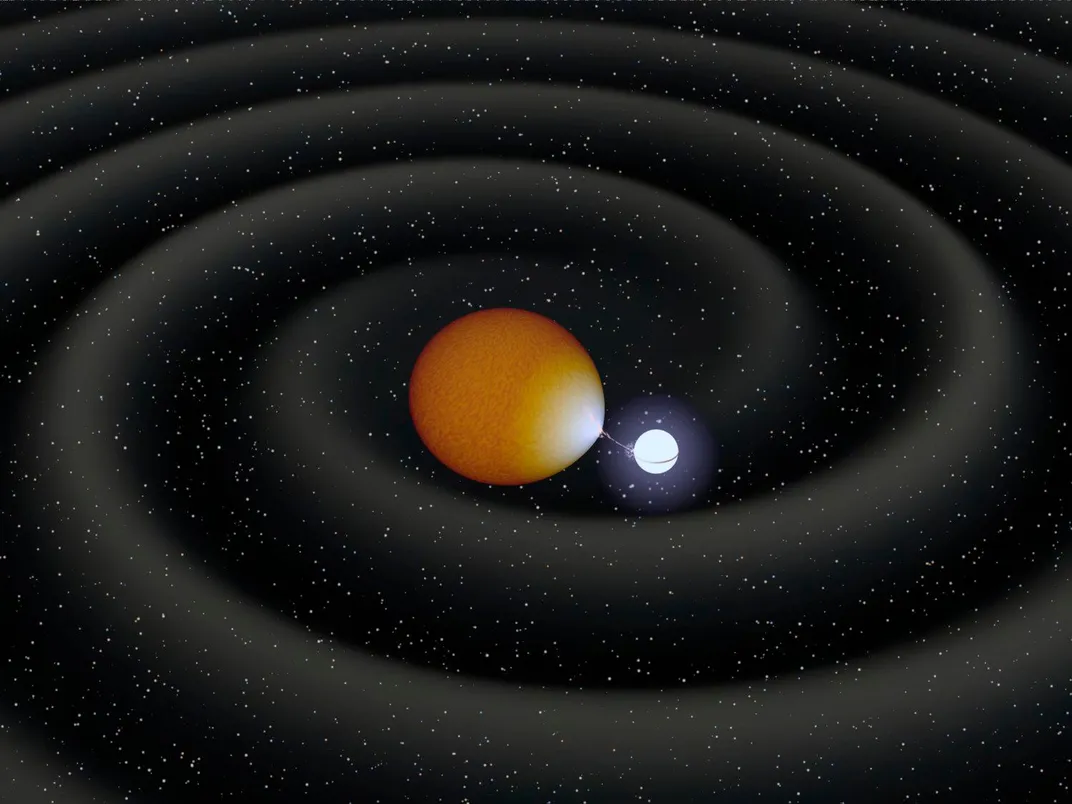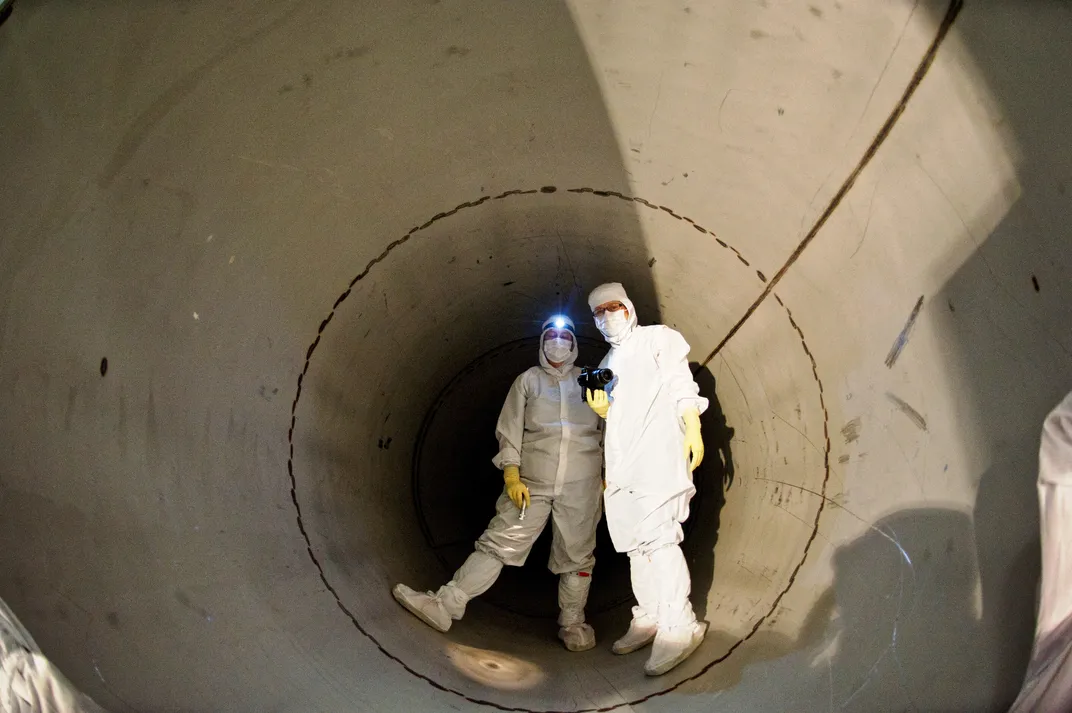The Search for Gravitational Waves
Astronomers built some of the most precise instruments on Earth to hear them.
/https://tf-cmsv2-smithsonianmag-media.s3.amazonaws.com/filer/fc/44/fc443cf3-c288-43f4-8d0a-3fcda42c6ac5/12a_jj2015_1blackholesconcept_live.jpg)
Think of it as a low hum, a rumble too deep to notice without special equipment. It permeates everything—from the emptiest spot in space to the densest cores of planets. Unlike sound, which requires air or some other material to carry it, this hum travels on the structure of space-time itself. It is the tremble caused by gravitational radiation, left over from the first moments after the Big Bang.
Gravitational waves were predicted in Albert Einstein’s 1916 theory of general relativity. Einstein postulated that the gravity of massive objects would bend or warp space-time and that their movements would send ripples through it, just as a ship moving through water creates a wake. Later observations supported his conception.
The imprint of this type of radiation on the oldest light in the universe—the cosmic microwave background (CMB)—is one prediction of inflation theory, which was first proposed in 1979. That theory states that the universe, originally chaotic quantum noise made of unstable particles and space-time turbulence, expanded at an unimaginable rate, creating these gravitational waves, smoothing out the chaos, and leaving the orderly cosmos we see today.
“Gravitational waves allow us to see all the way back to the start to the universe,” says Katherine Dooley, a postdoctoral researcher at the California Institute of Technology in Pasadena. “The early universe was too dense such that standard electromagnetic waves”—light—“would get scattered off of all the material, and could not travel to us today.” Observing these gravitational waves might confirm what we know about general relativity, or they might give us new insight into the nature of the universe, like whether the Big Bang was the beginning of all time, or if another universe preceded ours. The story of the universe’s origin is best told through this primordial rumble…if we can figure out how to detect it. A few gravitational wave observatories have been built—none has yet detected a wave—and more are planned over the next few decades. It’s an exciting time for astronomers, who may soon have real evidence on which to ground this new branch of one of the oldest scientific disciplines.
Practically every action makes gravitational waves—you can create them by waving your arms—but it takes serious astronomical doings to generate anything powerful enough to be detected. Earth orbiting the sun produces them, but they are low energy (which is good for the long-term stability of our solar system); two pulsars, the ultra-compact remnants of massive stars, locked in binary orbit produce far more substantial waves. As those bodies sweep around each other, they compress and expand the structure of space-time itself, creating a disturbance that travels out at the speed of light.
Gravitational waves from binaries like this are regular, like a pure note from a single string of an instrument. In principle we could trace such a signal back to its source, though, as with sound, triangulation is less precise than for light. Primordial radiation, on the other hand, comes from every place at once, since it was produced everywhere, when the universe was much smaller, and traveled in all directions from where it was created. The ultimate sources were tiny fluctuations in the quantum chaos that was the cosmos right after the Big Bang; the gravitational ripples created by the fluctuations stretched out when the universe expanded rapidly into large, solar system-spanning waves.
In the pipe organ that is the gravitational-wave universe, inflation would be the longest, largest pipes, producing sounds so low-pitched they are felt rather than heard. Binary pulsars would lie toward the middle register, and violent catastrophes like supernovas or cosmic collisions would be the short, piccolo pipes. “Hearing” each type of wave requires equipment tuned to the appropriate register.
The principle of detection is simple: As gravitational waves pass by, they massage matter, squeezing and stretching it along the waves’ crests and troughs. The effect of the wave is recorded as its “strain” on the detector, though that strain is tiny by everyday standards. So far, nobody has detected gravitational waves directly, though indirect detections abound. The most famous is the Hulse-Taylor binary pulsar, named for the two researchers who discovered it 40 years ago. Russell Hulse and Joseph Taylor earned a Nobel Prize in physics for their observation that the two pulsars were orbiting closer and closer together, and the energy leaving the system as the orbit decayed was the same as what the general theory of relativity predicted would be lost due to gravitational waves. Since then, other astronomers identified even stronger gravitational wave sources, including a pair of white dwarfs—the last life stage of stars less massive than the sun—which take just 12 minutes to orbit each other.
But this indirect detection isn’t satisfying: Astronomers want to detect the waves themselves. “As with all new windows you open on the universe, there’s going to be things we’re going to find [with gravitational waves] and we have no idea what the hell they are,” says Matt Benacquista of the University of Texas at Brownsville. Historically, every new type of astronomical observation, from radio waves to gamma rays, has led to unexpected discoveries, and gravitational waves are likely to be no different. “That in many ways is the most exciting part about doing this,” says Benacquista.
Yet for a number of reasons, the problem of direct detection is vexing. Like sound, gravitational waves are comparable in size to whatever produces them. Large systems, like big black holes orbiting each other at the centers of galaxies, will make very-long-wavelength, low-frequency waves, which require suitably huge detectors. Even relatively small sources, such as a pair of pulsars very close to collision, require detectors measuring more than a mile across. If they exist, primordial gravitational waves from inflation would exist at a wide range of wavelengths, but only extremely long ones—those with a wavelength comparable in size to Earth’s orbit around the sun—would provide a large enough signal for astronomers to detect.
Technically we are bathed in the “sound” of gravitational radiation all the time, but the sound is faint and usually too low-pitched. Gravity is by far the weakest of the four fundamental forces of nature, and its influence grows smaller with distance, so when a gravitational wave—even a relatively powerful one—passes by, very little energy gets transferred. To make matters more difficult, since the effect on matter is to push it around, detectors on the ground must deal with interference by anything that could make them vibrate, from earthquakes to big trucks rumbling by.
So observatories must be large, sensitive to faint signals, and isolated as completely as possible from any stray vibrations. That’s a tall order, solved best by building multiple observatories or launching detectors into space. Scientists, being resourceful creatures, are doing both.
Katherine Dooley got hooked on gravitational radiation research during a summer undergraduate fellowship at Caltech, which, with the Massachusetts Institute of Technology, operates the two Laser Interferometer Gravitational-wave Observatories (LIGO) in the United States: one in Richland, Washington, and the other in Livingston, Louisiana. For her doctoral dissertation, she spent four years designing the apparatus in Livingston to be more sensitive through the use of more laser power. She moved to Hannover, Germany, to do her postdoc research at GEO600, a gravitational wave observatory that began operation in 2002. She’s now back working with LIGO, just in time for the inauguration of the upgrades she helped institute.
With her experience in detector design, Dooley understands the challenge of gravitational wave observation better than most people. Ground-based observatories like LIGO and GEO600 are similar: powerful laser beams travel down two “arms,” at the ends of which the light strikes a mirror, which reflects it back to its source. When a gravitational wave passes by, the mirror should move, changing the distance the light travels ever so slightly. By running its two observatories simultaneously, LIGO can better eliminate local disturbances—when a gravitational wave passes through Earth, both observatories should feel it. The size of gravitational wave sources necessitates long arms: At the LIGO facilities the arms are four kilometers (two and a half miles) long; GEO600’s are 600 meters (hence the name).
Benacquista is the kind of gravitational wave astrophysicist who prefers to take notes with a fountain pen. Like Dooley, he has worked with two observatory projects, one of which was LIGO, from 2006 to 2013, albeit from the theoretical side: He characterizes the sources of gravitational waves that detectors might see. In 1995, a summer research program at NASA’s Jet Propulsion Laboratory connected him with an exciting project just getting started, the Laser Interferometer Space Antenna (LISA). As the name suggests, LISA will be a space-based observatory designed to orbit the sun, made of three small spacecraft in a V-formation, each separated by a million kilometers. The basic operation is similar to LIGO: By measuring the distance between each spacecraft using laser light, researchers can detect a gravitational wave as it compresses or expands the space-time between the spacecraft.
Conceived as a joint project between NASA and the European Space Agency, LISA was originally projected to launch between 2012 and 2016. However, NASA withdrew participation in 2011, leaving the very expensive project entirely up to ESA. By cutting back on the ambition a bit, the project survived as European LISA, or eLISA, but now the launch date is 2034, which is far enough in the future to make any forecasts doubtful.
“I’m still kind of pessimistic about LISA,” Benacquista says. He’s hopeful that when LIGO detects the signal from colliding neutron stars in the next five years or so, the LISA launch might get pushed up by a few years, but that still doesn’t place it in the next decade. “Hopefully I’ll still be alive!” he laughs ruefully.
On track, however, is the LISA demonstration mission slated to launch later this year. Called LISA Pathfinder, it will test the instrumentation and physical concepts the observatory will use: lasers and masses, which are, like the mirrors on LIGO, designed to move independently of the spacecraft. Additionally, the GRACE Follow-On (Gravitational Recovery And Climate Experiment) mission, targeted to launch in 2017, will observe tiny fluctuations in Earth’s gravitational field by measuring the distance between two independently flying spacecraft, just as LISA will do. The mission is a follow-up to the previous GRACE and GRAIL (Gravity Recovery And Interior Laboratory) probes, which performed the same duty for the moon in 2012. To gravitational wave researchers, the successes of these missions, coupled with the delays on LISA, are a simultaneous joy and frustration.
“Bicep2 is an experiment that aims to do just one thing and do it well,” says Walt Ogburn, a cosmologist at Stanford University who spent the summer of 2009-2010 at the South Pole installing the telescope. That one thing BICEP2 was designed to do: measure the polarization of the cosmic microwave background. The CMB comes from a time when the universe cooled enough to become transparent, about 380,000 years after the Big Bang. Similar to the way polarizing sunglasses reduce glare by filtering light, various cosmological objects—big galaxies, cosmic dust molecules, and gravitational waves—filter the cosmic background radiation in interesting ways.
“Since these fluctuations [waves] are in space-time, they stretch or compress space—and particles—as they pass,” says Renée Hložek, a postdoc at Princeton University involved with the Atacama Cosmology Telescope polarization project, or ACTPol, in Chile, another experiment to measure the polarization of the CMB. The particles Hložek refers to include photons, the particles of light. Because gravitational waves squeeze space-time in one direction and stretch it in the other (something known as tensor modes), Hložek says, “the pattern of polarization induced from these gravitational waves is very specific.” Experiments like BICEP2 and ACTPol are trying to confirm inflation theory by discovering the primordial gravitational waves such rapid expansion would have created; they are observing the light—the CMB—the waves should have polarized.
But while these observatories are very good at measuring polarization, they can’t tell us exactly what is causing it. In March 2014, researchers with BICEP2 announced they detected the polarization—evidence of gravitational waves—and thus confirmed inflation theory. Stanford University even released a moving video showing professor and BICEP2 researcher Chao-Lin Kuo bringing news of the experiment’s results to Andrei Linde, one of the most influential authors of inflation theory. Chao-Lin surprised Linde at his home with champagne to toast the “smoking gun” that proved Linde’s life’s work to be true. The excitement turned out to be premature. More ordinary phenomena—such as dust particles in the Milky Way—can polarize light in a similar way, and after follow-up study by the European Space Agency’s Planck spacecraft, the BICEP2 team revised its initial findings to say that it’s possible the entire signal was caused by cosmic dust.
A successor experiment, BICEP3, installed in Antarctica early this year, along with ACTPol and other studies, will help by adding more data, but gravitational wave signals might still hide from such detection. That brings us back to the question of direct detection. As Walt Ogburn points out, the Big Bang Observer would be able to settle the issue of inflation for good. A possible follow-up to LISA, the project as initially proposed would consist of 12 satellites in three groupings that would orbit around the sun. The vast scale would provide the ability to measure gravitational radiation with wavelengths comparable to the size of the solar system—what we would expect from inflation.
Not only could the Observer confirm results from polarization observatories, it also could discover things about the fundamental structure of the cosmos. As Ogburn points out, these early waves “also represent new physics at energies a trillion times higher than what we can reach at the [Large Hadron Collider].” They could even help settle one of the looming conundrums in modern physics: understanding the quantum mechanical properties of gravity.
Even though LIGO and GEO600 are remarkably sensitive instruments, they are simply too small to observe primordial gravitational waves. Their mission is elsewhere: detecting waves caused by colliding black holes, neutron stars, and other relatively compact objects that pack a lot of energy. And as large as LISA will be, its million-kilometer arms will still be too short for the largest gravitational waves. The Big Bang Observer is currently the best hope we have, and it is far in the future.
Like other gravitational wave researchers, Katherine Dooley and Matt Benacquista are philosophical about the lack of direct detections so far. Gravitational wave research is difficult, and the waves that would be easiest to detect because they’re the most common—those from binary pulsars and black holes—could be detected only by bigger detectors than we can build on Earth’s surface.
For that reason, nobody in the field was really surprised when the first iterations of LIGO didn’t see anything. Each phase of LIGO was always intended to be a learning process, much as engineers build and test many rocket prototypes before settling on a design to launch valuable payloads aboard. The deepest concern now is “noise hunting,” says Dooley, identifying all the environmental and technical disturbances that could get in the way of being able to see a clear signal from a gravitational wave when one comes along.
Advanced LIGO, the version with Dooley’s upgrades that began operation last February, has ten times the sensitivity of the original experiment. In practical terms, that means it can “hear” ten times as far, which represents a volume of the universe that is a thousand times greater. In that pocket of space, says Dooley, signals from colliding neutron stars “could be as infrequent as once a year or once every other year, or even as frequent as almost every day.” If Advanced LIGO detected one gravitational wave signal per month, that would be enough to keep researchers busy and happy for some time.
When astronomers finally detect gravitational waves, what doors to our understanding of the universe will open? Benacquista doesn’t mind not knowing in advance: “That’s one of the things I really like about astrophysics. It’s like a game where you’ve been told the conclusion to a story, and now you have to invent the story that got you to that point.” With every new field in astronomy, scientists discovered something unexpected: radio astronomy led to pulsars, X-ray astronomers found black holes, microwave antennas detected the cosmic microwave background. If this first generation of gravitational researchers at last hears the rumble of the first moments of the universe, they may find themselves, thrillingly, at the beginning again.
